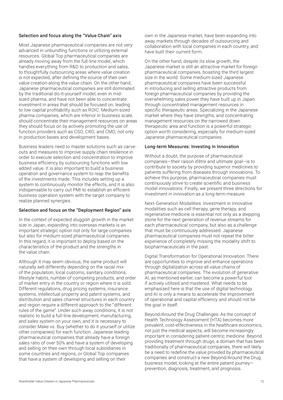
12
Shareholder Value Creation in Japanese Pharmaceuticals
Selection and focus along the "Value Chain" axis
Most Japanese pharmaceutical companies are not very
advanced in unbundling functions or utilizing external
resources. Global Top pharmaceutical companies are
already moving away from the full-line model, which
handles everything from R&D to production and sales,
to thoughtfully outsourcing areas where value creation
is not expected, after defining the source of their own
value creation along the value chain. On the other hand,
Japanese pharmaceutical companies are still dominated
by the traditional do-it-yourself model, even in midsized
pharma, and have not been able to concentrate
investment in areas that should be focused on, leading
to low capital profitability such as ROIC. Medium-sized
pharma companies, which are inferior in business scale,
should concentrate their management resources on areas
they should focus on by actively promoting the use of
function providers such as CSO, CRO, and CMO, not only
in production bases and development bases.
Business leaders need to master solutions such as carveouts
and measures to improve supply chain resilience in
order to execute selection and concentration to improve
business efficiency by outsourcing functions with low
added value. It is also important to build a business
operation and governance system to reap the benefits
of the investments made. This includes setting up a
system to continuously monitor the effects, and it is also
indispensable to carry out PMI to establish an efficient
business operation system with the target company to
realize planned synergies.
Selection and focus on the "Deployment Region" axis
In the context of expected sluggish growth in the market
size in Japan, expanding into overseas markets is an
important strategic option not only for large companies
but also for medium-sized pharmaceutical companies.
In this regard, it is important to deploy based on the
characteristics of the product and the strengths in
the value chain.
Although it may seem obvious, the same product will
naturally sell differently depending on the racial mix
of the population, local customs, sanitary conditions,
lifestyle habits, number of competing products, and order
of market entry in the country or region where it is sold.
Different regulations, drug pricing systems, insurance
systems, intellectual property and patent systems, and
distribution and sales channel structures in each country
and region require a different approach to the "different
rules of the game". Under such away conditions, it is not
realistic to build a full-line development, manufacturing,
and sales system on your own, and it is necessary to
consider Make vs. Buy (whether to do it yourself or utilize
other companies) for each function. Japanese leading
pharmaceutical companies that already have a foreign
sales ratio of over 50% and have a system of developing
and selling on their own through local subsidiaries in
some countries and regions, or Global Top companies
that have a system of developing and selling on their
own in the Japanese market, have been expanding into
away markets through decades of outsourcing and
collaboration with local companies in each country, and
have built their current form.
On the other hand, despite its slow growth, the
Japanese market is still an attractive market for foreign
pharmaceutical companies, boasting the third largest
size in the world. Some medium-sized Japanese
pharmaceutical companies have been successful
in introducing and selling attractive products from
foreign pharmaceutical companies by providing the
overwhelming sales power they have built up in Japan
through concentrated management resources in
specific therapeutic areas. Specializing in the Japanese
market where they have strengths, and concentrating
management resources on the narrowed down
therapeutic area and function is a powerful strategic
option worth considering, especially for medium-sized
Japanese pharmaceutical companies.
Long-term Measures: Investing in Innovation
Without a doubt, the purpose of pharmaceutical
companies-their raison d'être and ultimate goal-is to
contribute to society by providing superior medicines to
patients suffering from diseases through innovations. To
achieve this purpose, pharmaceutical companies must
continuously strive to create scientific and business
model innovations. Finally, we present three directions for
investment in innovation as a long-term measure.
Next-Generation Modalities: Investment in innovative
modalities such as cell therapy, gene therapy, and
regenerative medicine is essential not only as a stepping
stone for the next generation of revenue streams for
each pharmaceutical company, but also as a challenge
that must be continuously addressed. Japanese
pharmaceutical companies must not repeat the bitter
experience of completely missing the modality shift to
biopharmaceuticals in the past.
Digital Transformation for Operational Innovation: There
are opportunities to improve and enhance operations
through digitalization across all value chains of
pharmaceutical companies. The evolution of generative
AI, as mentioned earlier, can become a powerful tool
if actively utilized and mastered. What needs to be
emphasized here is that the use of digital technology
and AI is only a means to accelerate the improvement
of operational and capital efficiency and should not be
the goal in itself.
Beyond/Around the Drug Challenges: As the concept of
Health Technology Assessment (HTA) becomes more
prevalent, cost-effectiveness in the healthcare economics,
not just the medical aspects, will become increasingly
important in considering patient-centric medicine. Beyond
providing treatment through drugs, a domain that has been
traditionally of pharmaceutical companies, there will likely
be a need to redefine the value provided by pharmaceutical
companies and construct a new Beyond/Around the Drug
business model, looking at the entire patient journey-
prevention, diagnosis, treatment, and prognosis.